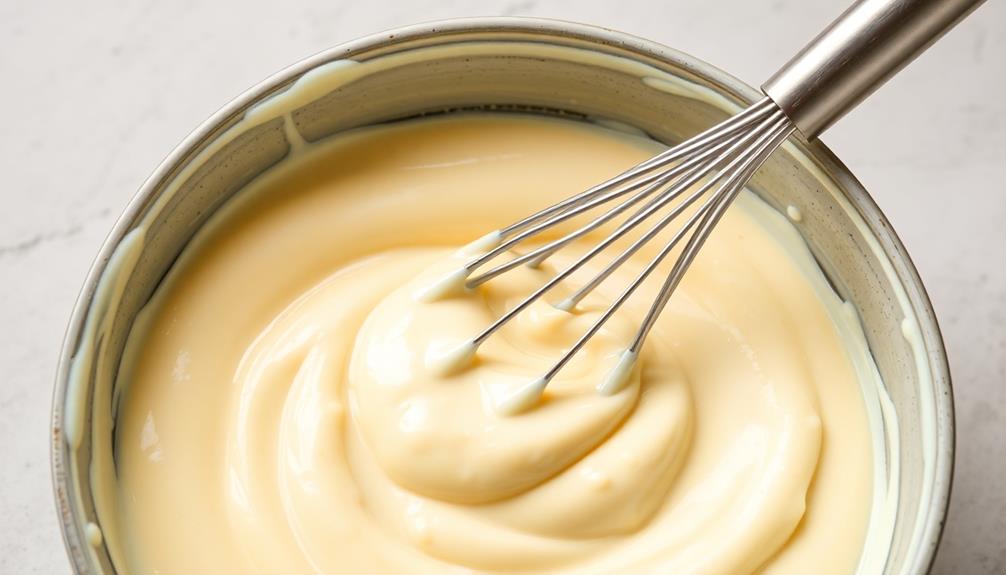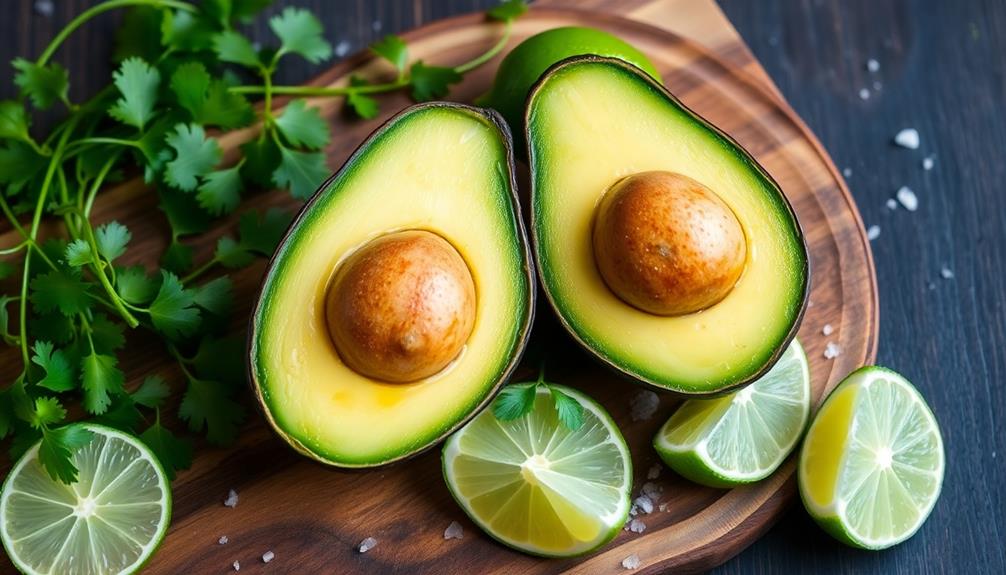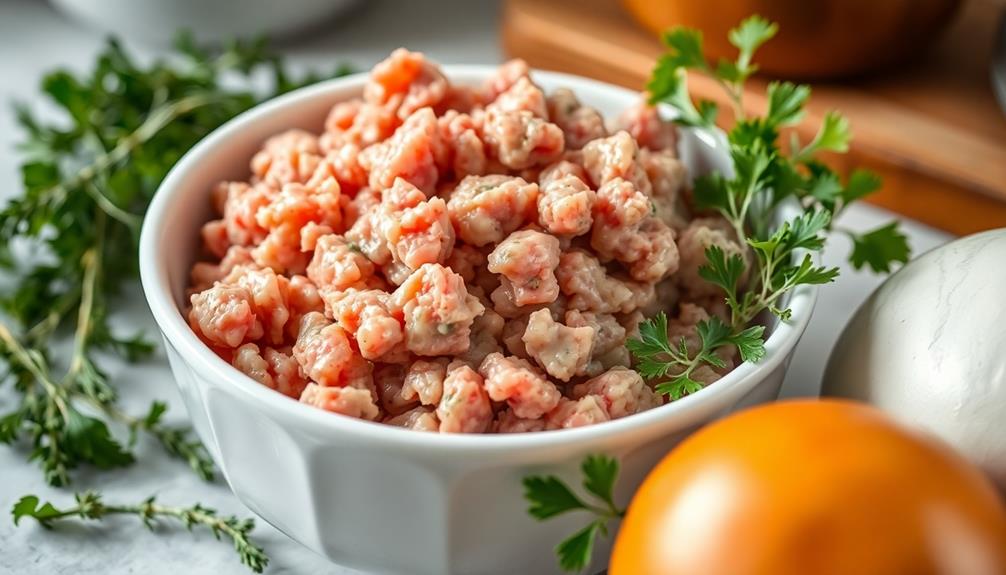Making homemade mayonnaise couldn't be simpler. Start by cracking eggs into a bowl, then slowly whisk in oil to emulsify the mixture. Add a touch of lemon juice or vinegar for tang, season with salt and pepper, and voilà – you've got a rich, creamy condiment that far surpasses store-bought options. The best part? You control the ingredients, so you can customize the flavor to your liking. Once you get the hang of it, you'll wonder why you ever bothered with store-bought mayo. Want to learn more about mastering this kitchen staple?
Key Takeaways
- Gather essential ingredients: egg yolks, Dijon mustard, lemon juice or vinegar, salt, and oil.
- Slowly add oil to egg yolks while continuously whisking to emulsify and thicken the mixture.
- Incorporate lemon juice or vinegar to add acidity and balance the flavor.
- Season with salt and pepper to taste, adjusting as needed.
- Homemade mayonnaise offers superior flavor and customizability compared to store-bought options.
History
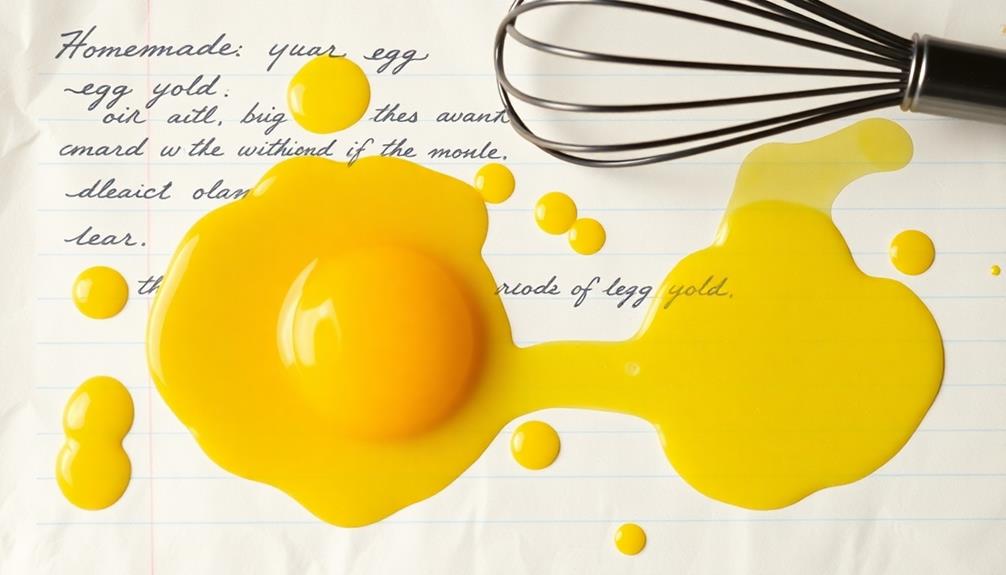
Though the exact origins of mayonnaise are unclear, it's believed to have emerged as a popular condiment in the mid-18th century. The name "mayonnaise" likely derives from the French city of Mahón, where a similar sauce was first created.
This creamy emulsion of egg yolks, oil, and vinegar was likely popularized by the Duke of Richelieu after his victory in Mahón in 1756. From there, mayonnaise spread throughout Europe and eventually made its way to the United States in the 19th century.
Over time, it became a staple in kitchens around the world, used in everything from sandwiches to salads. Today, homemade mayonnaise is prized for its rich, velvety texture and customizable flavor profile.
Whether you prefer it tangy or mild, making your own mayonnaise allows you to control the ingredients and create the perfect condiment to suit your tastes.
Recipe
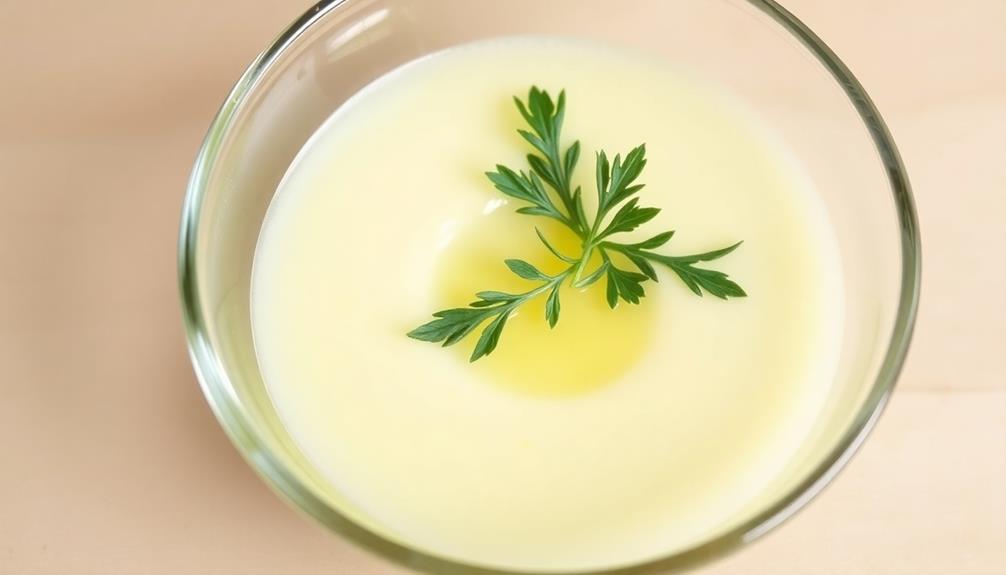
Making homemade mayonnaise is a rewarding and versatile skill that allows you to create a creamy, tangy condiment tailored to your taste preferences.
Homemade mayonnaise isn't only more flavorful than store-bought varieties, but it also allows you to control the ingredients, ensuring a healthier and more natural end product. With just a few simple steps, you can whip up a batch of this culinary staple right in your own kitchen.
Ingredients:
- 1 large egg yolk
- 1 tbsp Dijon mustard
- 1 tbsp lemon juice or white wine vinegar
- 1/2 tsp salt
- 1 cup vegetable or olive oil
Instructions: In a medium bowl, whisk together the egg yolk, Dijon mustard, lemon juice or vinegar, and salt until well combined.
Slowly, while continuously whisking, drizzle in the oil, a few drops at a time, until the mixture begins to emulsify and thicken. Once the mixture has thickened, you can gradually add the oil in a thin, steady stream, whisking constantly, until all the oil is incorporated and the mayonnaise is thick and creamy.
For best results, use the mayonnaise immediately or store it in an airtight container in the refrigerator for up to 1 week.
Be sure to discard any leftover mayonnaise if it has been sitting at room temperature for more than 2 hours, as raw egg can pose a food safety risk. Enjoy your homemade mayonnaise on sandwiches, as a dip, or in a variety of other dishes.
Cooking Steps
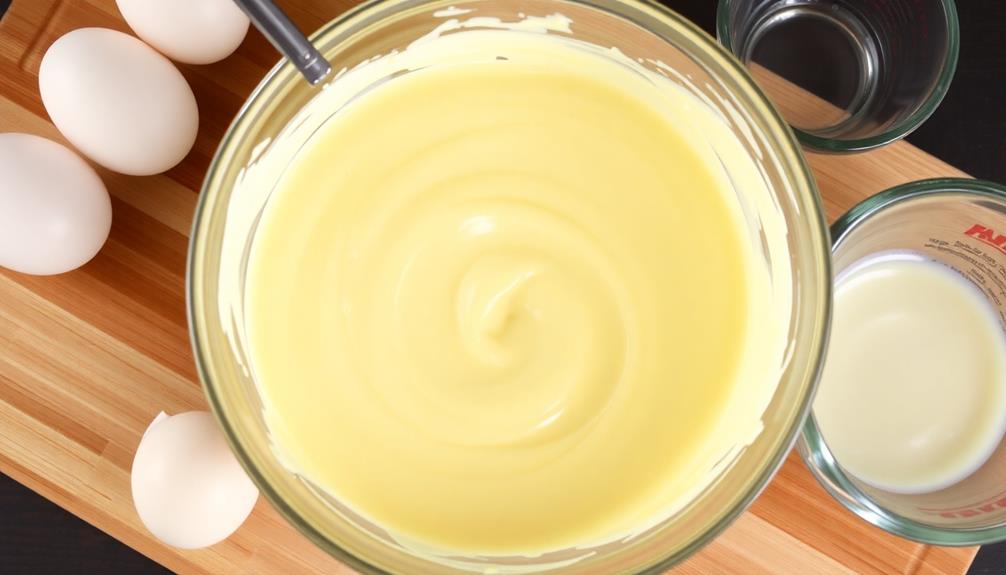
Crack the eggs into a mixing bowl.
Slowly pour in the oil, whisking the mixture continuously as you go.
Step 1. Crack Eggs Into Mixing Bowl
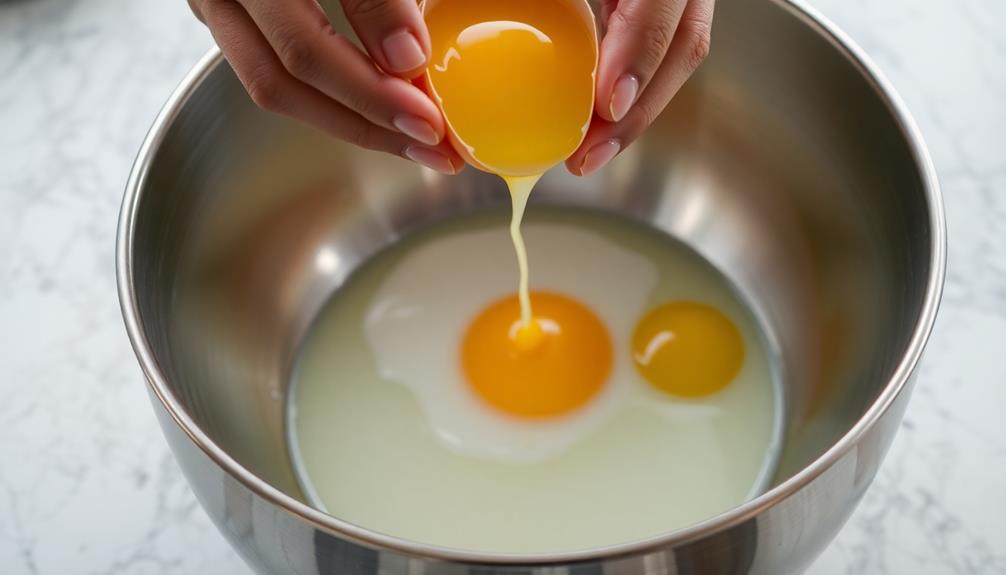
To begin, crack the eggs into a medium-sized mixing bowl. With a gentle tap on the counter, split the eggshells in half and carefully pour the contents into the bowl, discarding the shells.
Make sure no bits of shell fall into the eggs, as you'll want a smooth, uninterrupted mixture for your homemade mayonnaise.
Next, examine the eggs to ensure they're fresh and free of any cracks or blemishes. Gently separate the yolks from the whites, reserving only the yolks for this recipe.
The whites can be saved for another use, such as meringues or scrambled eggs. Carefully transfer the egg yolks to the mixing bowl, taking care not to break them.
Once all the yolks are in the bowl, you're ready to move on to the next step in creating your creamy, flavorful homemade mayonnaise.
Step 2. Add Oil Slowly
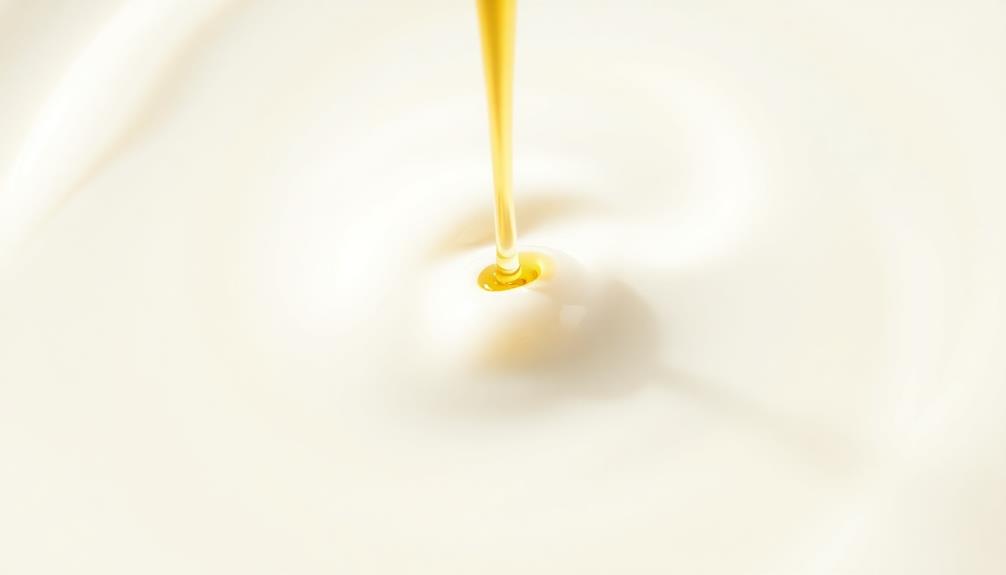
Slowly pour the oil into the egg yolks, drop by drop, while continuously whisking the mixture. This slow process helps emulsify the oil and eggs, creating the smooth, creamy texture of mayonnaise.
Be patient and take your time – rushing the oil addition can cause the mayonnaise to separate or curdle.
As you whisk, imagine a thin stream of oil being carefully incorporated into the yolks. Keep the whisk moving in a circular motion, ensuring the oil blends evenly.
If the mixture starts to thicken too quickly, slow down the oil addition. Conversely, if it seems too thin, you can increase the flow of oil slightly.
The goal is to gradually build up the body of the mayonnaise, transforming the liquid yolks into a rich, velvety condiment.
With practice, you'll develop a feel for the right pace and consistency. Enjoy the satisfaction of making your own homemade mayonnaise from scratch!
Step 3. Whisk Egg Mixture Continuously
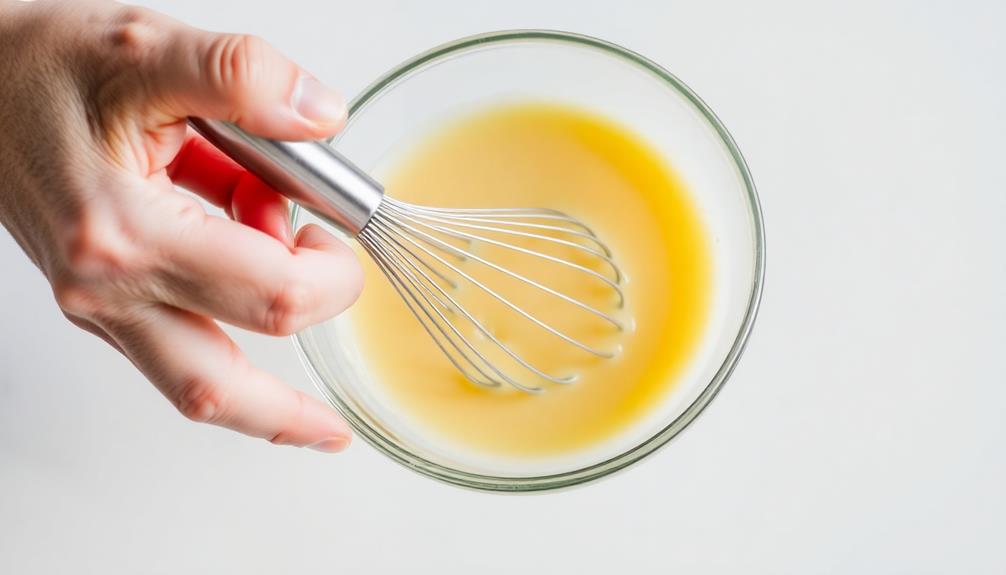
Continuously whisk the egg yolks as you slowly pour in the oil. This is a crucial step in making homemade mayonnaise. The steady whisking helps emulsify the mixture, creating a thick, creamy texture.
Go slowly, adding the oil just a few drops at a time, while vigorously whisking the egg yolks. As you whisk, you'll notice the mixture starting to thicken and become opaque. This is a good sign that the emulsion is forming properly.
Keep whisking until all the oil has been incorporated. Don't worry if the mayonnaise looks a bit thin at first – it will continue to thicken as you whisk.
If the mixture starts to separate or curdle, don't panic. Simply start over with a new egg yolk and slowly reintegrate the failed batch.
With a little practice, you'll get the hang of the continuous whisking technique. Patience and attentiveness are key for perfectly smooth, homemade mayonnaise.
Step 4. Add Lemon Juice or Vinegar
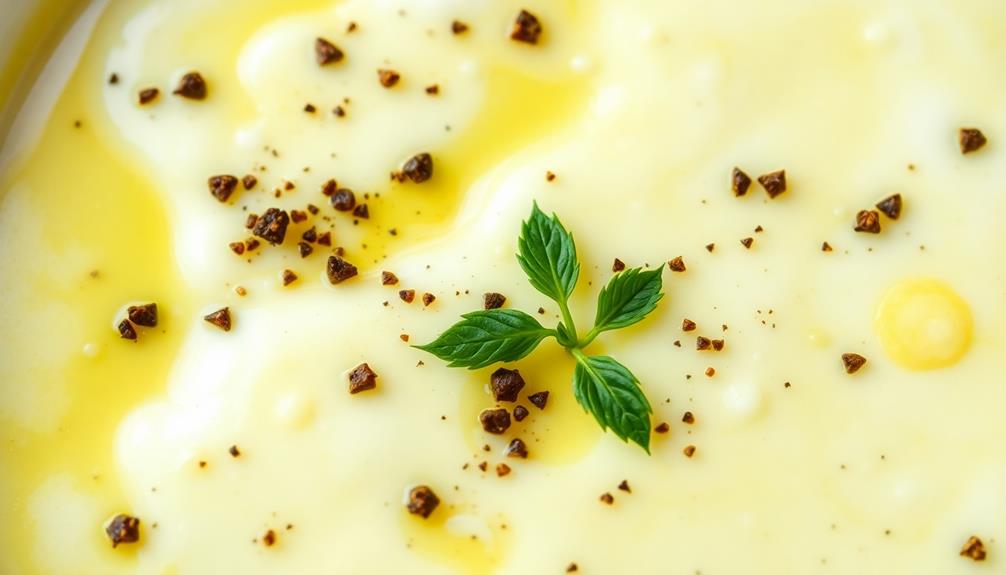
Having emulsified the oil into the egg yolks, you'll now want to add the lemon juice or vinegar. This is a crucial step that balances the richness of the mayo with a touch of acidity.
Start by adding just a teaspoon of lemon juice or white wine vinegar, then whisk it in thoroughly. Taste the mixture and add more if you'd like a tangier flavor. Be careful not to overdo it, though, or your mayo could become overpowering.
The acidity helps to stabilize the emulsion, so it's an important component. After whisking in the lemon or vinegar, give the mixture another taste. If it needs a bit more seasoning, you can add a pinch of salt.
Just be sure to whisk everything together until it's fully incorporated. Now your homemade mayo is ready to use in all sorts of delicious dishes!
Step 5. Season With Salt and Pepper
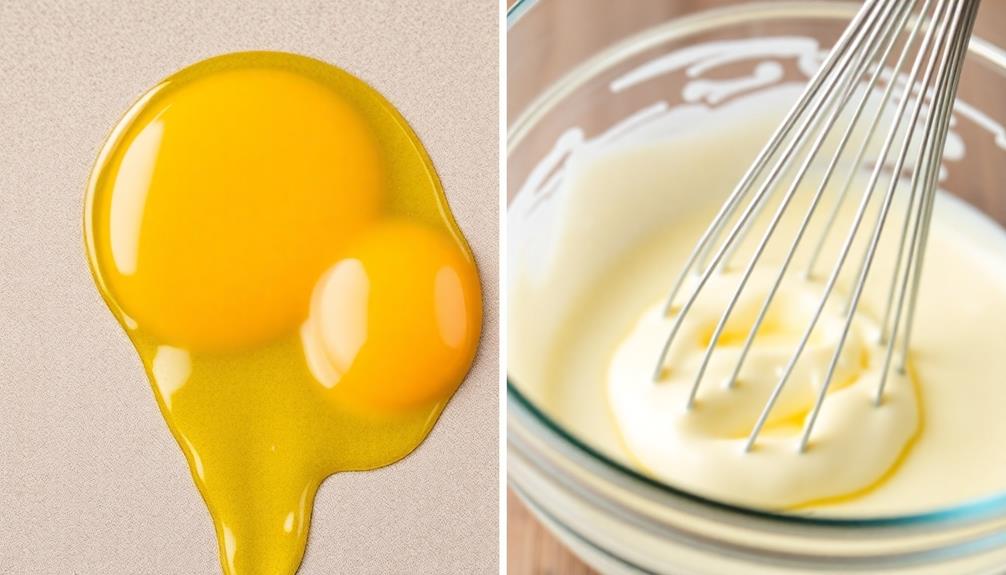
With the lemon juice or vinegar now incorporated, the final touch is to season your homemade mayonnaise with salt and pepper.
Start by adding a pinch of salt and a few grinds of black pepper to the mixture. Gently stir to combine, then taste and adjust the seasoning as needed.
The amount of salt and pepper you use will depend on your personal preferences, so feel free to experiment until you find the perfect balance.
Final Thoughts
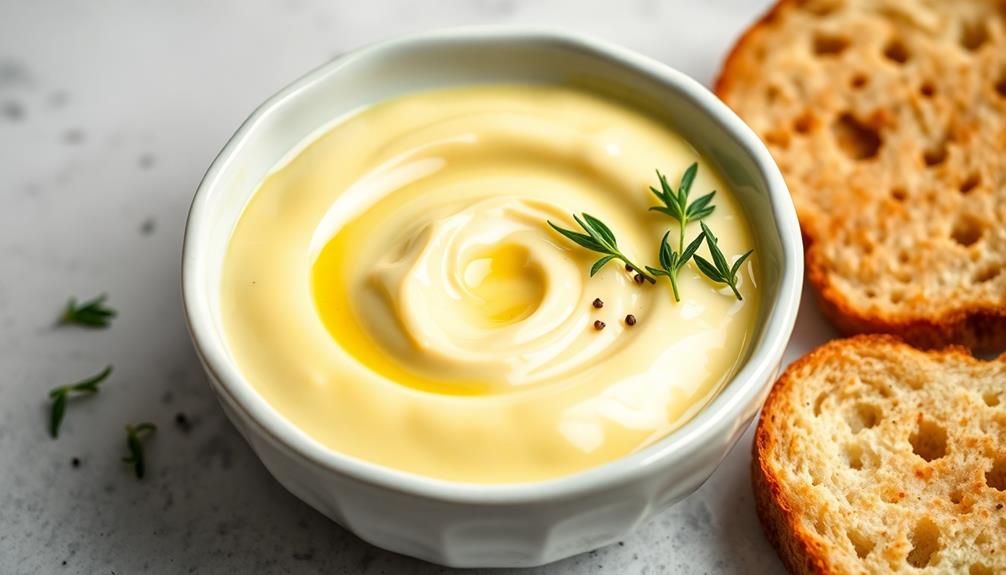
Making homemade mayonnaise may seem like a daunting task, but the satisfaction of crafting this versatile condiment from scratch is well worth the effort. With the right technique and a few simple ingredients, you'll have a creamy, flavorful mayonnaise that outshines anything store-bought.
Don't be intimidated by the process – it's actually quite straightforward, and once you get the hang of it, you'll be whipping up batches of homemade mayo in no time.
Beyond the joy of creating it yourself, homemade mayonnaise offers several advantages. It's free of preservatives and artificial additives, allowing you to control the quality and freshness of the ingredients.
Plus, you can customize the flavor to your liking, whether that's adding a hint of garlic, a splash of lemon, or your favorite herbs and spices. So why not give it a try? Homemade mayonnaise is a game-changer that's sure to elevate your culinary creations.
Frequently Asked Questions
What if the Mayonnaise Doesn't Emulsify Properly?
If the mayonnaise doesn't emulsify properly, don't worry. You can try whisking in an extra egg yolk or a teaspoon of water to help the ingredients bind together. With a little patience, you can fix the issue.
How Long Can Homemade Mayonnaise Be Stored?
Homemade mayonnaise can typically be stored in the refrigerator for up to 4 days. Be sure to store it in an airtight container and use it within that time frame for the best quality and safety.
Can I Use a Hand Mixer Instead of a Blender?
You can absolutely use a hand mixer instead of a blender to make homemade mayonnaise. The process may take a bit longer, but you'll get the same delicious results with a hand mixer. Just be sure to slowly drizzle in the oil as you mix.
Is It Safe to Use Raw Eggs in Mayonnaise?
Using raw eggs in homemade mayonnaise can pose a food safety risk, as they may contain harmful bacteria like Salmonella. It's generally safer to use pasteurized eggs instead to minimize the risk of foodborne illness.
Can I Add Different Flavors to the Mayonnaise?
You can absolutely add different flavors to your mayonnaise! Feel free to experiment with herbs, spices, or even citrus juices to create unique and delicious variations to suit your taste preferences.

